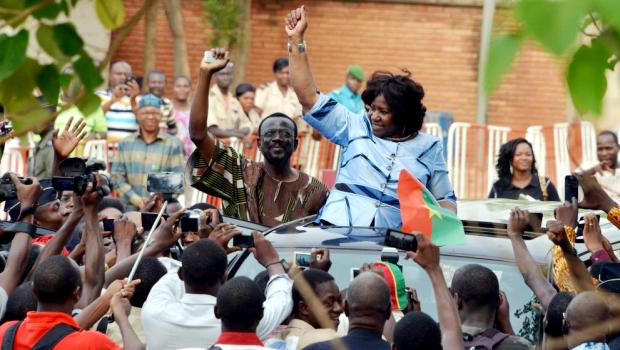
Ouagadougou – Mariam Sankara, the widow of Burkina Faso’s ex-President Thomas Sankara, returned home today after 27 years.
She arrived in Ouagadougou on Thursday to assist in investigation of her husband’s assassination, according to officials.
Sankara will also attend the national convention of Sankarist parties between May 16 to 17, 2015.

Sankara led Burkina Faso’s revolution from Aug. 4, 1983, until his assassination on Oct. 15, 1987, after which Compaore took over power.
In early May, Burkina Faso’s military tribunal appealed to witnesses in his murder to get in touch with competent authorities, two weeks after his grave was sealed off.
Since the death of her husband, Sankara has been living in France, and returned to Burkina Faso once in 2007.
She is equally expected to be interviewed by the military judicial authorities who are investigating Sankara’s assassination.

Mariam Sankara (née Sereme, born 26 March 1953 is the widow of Thomas Sankara, the President of Upper Volta (later renamed Burkina Faso) from 4 August 1983 until his assassination on 15 October 1987. During this time she was First Lady of the country. Thomas Sankara, a Marxist and pan-Africanist army officer, became President of what was then known as the Republic of Upper Volta after a military coup in August 1983. He attempted to carry out what he dubbed the “Democratic and Popular Revolution” (French: Révolution démocratique et populaire), implementing many radical reforms. Sankara was killed in a coup in October 1987, orchestrated by his former friend and colleague Blaise Compaoré.
As a result of the coup, Mariam Sankara was forced to flee Burkina Faso along with her two children, Philippe (born 10 August 1980) and August (born 21 September 1982). She went into exile in France, where she would spend the next twenty years. Meanwhile, she was replaced as First Lady by Chantal Compaoré. In 1997 she filed a complaint to a Burkinabé court regarding the murder of Thomas, but it wasn’t until 28 June 2012 that the Supreme Court ruled that the case could be prosecuted under local jurisprudence. With the gradual opening up of the country’s military regime, Sankara was eventually able to return to her home country in 2007, to attend commemorations held in honour of the 20-year anniversary of her husband’s death. Large crowds greeted her return to the capital Ouagadougou.
In late October 2014, a large-scale uprising broke out in Burkina Faso, protesting President Blaise Compaoré’s attempts to prolong his 27-year rule. As a result of the protests, partially inspired by the memory of Thomas Sankara, Compaoré was forced to resign and flee the country. In response to this uprising, Mariam Sankara issued a statement congratulating the Burkinabé people for their victory, and calling for Compaoré to be prosecuted for his crimes against the people. She ended the letter by stating: “Long live the Republic and long live Burkina! The motherland or death, we shall overcome
FRENCH VERSION

Elle est arrivée à Ouagadougou jeudi pour aider à l’enquête del’assassinat de son mari, selon les responsables.
Sankara assistera également à la convention nationale des partissankariste entre 16 et 17 mai 2015.
Sankara a mené révolution du Burkina Faso depuis le 4 août1983, jusqu’à son assassinat le 15 octobre 1987, après quoiCompaoré a pris le pouvoir.
Au début de mai, tribunal militaire du Burkina Faso a fait appelaux témoins dans son meurtre à contacter les autoritéscompétentes, deux semaines après que sa tombe a été bouclé.
Depuis la mort de son mari, Sankara a vécu en France et remiseau Burkina Faso une fois en 2007.
Elle devrait également être interrogé par les autorités judiciairesmilitaires qui étudient l’assassinat de Sankara.
Mariam Sankara (née Sereme, né le 26 mars 1953, est la veuve deThomas Sankara, le Président de la Haute-Volta (plus tardrebaptisé Burkina Faso) du 4 août 1983 jusqu’à son assassinat le15 octobre 1987. Pendant ce temps, elle était première dame dupays. Thomas Sankara, un marxiste et un officier de l’armée depanafricaniste, est devenu président de ce qui était alors connucomme la République de Haute-Volta après un coup d’Etatmilitaire en août 1983. Il a tenté de réaliser ce qu’il a baptisé la «révolution populaire démocratique, à et » (Français : Révolutiondémocratique et populaire), mise en œuvre de nombreusesréformes radicales. Sankara a été tué lors d’un putsch en octobre1987, orchestrée par son ancien ami et collègue BlaiseCompaoré.
À la suite du coup d’État, Mariam Sankara fut contraint de fuirBurkina Faso ainsi que ses deux enfants, Philippe (né le 10 août1980) et août (né le 21 septembre 1982). Elle part en exil enFrance, où elle dépenserait des vingt prochaines années. Pendant ce temps, elle fut remplacée comme première dame de ChantalCompaoré. En 1997, elle a déposé une plainte à un tribunal deBurkinabé au sujet du meurtre de Thomas, mais ce n’était pasjusqu’au 28 juin 2012 sur le fait que la Cour suprême a statué quel’affaire pourrait être poursuivi en vertu de la jurisprudencelocale. Avec l’ouverture progressive du régime militaire du pays,Sankara a finalement pu retourner dans son pays d’origine en2007, pour assister aux commémorations en l’honneur del’anniversaire des 20 ans de la mort de son mari. Une foulenombreuse a salué son retour dans la capitale Ouagadougou.
En fin octobre 2014, un soulèvement de grande ampleur ontéclaté au Burkina Faso, pour protester contre les tentatives duprésident Blaise Compaoré pour prolonger son règne de 27 ans.À la suite des manifestations, partiellement inspirées par lamémoire de Thomas Sankara, Compaoré a été contraint àdémissionner et à fuir le pays. En réponse à ce soulèvement,Mariam Sankara a publié une déclaration félicitant le peupleBurkinabé pour leur victoire et appelant à Compaoré d’êtrepoursuivi pour ses crimes contre le peuple. Elle a terminé la lettreen déclarant: « Long vivent la République et vive le Burkina ! Lapatrie ou la mort, nous vaincrons


